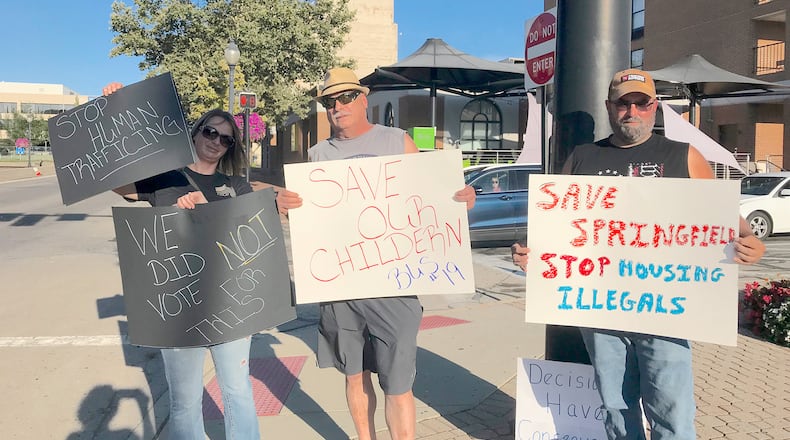Ohio’s unauthorized immigrant population is estimated at 89,000, according the most recent available data from an analysis by the non-partisan Migration Policy Institute using U.S. Census data and 2019 unauthorized immigrant population estimates provided by Jennifer Van Hook of The Pennsylvania State University.
But even though Ohio has far fewer unauthorized immigrants than many states, it is the top state for the amount of spending on political advertising mentioning immigration that ran on television, streaming platforms and digital during the first half of the year, according to an analysis by the Washington Post that published in August.
The Post found that 90% the 745 analyzed ads nationwide supported Republican candidates.
Credit: Erin Pence
Credit: Erin Pence
“The most spending is in Ohio for a few reasons. After Montana’s U.S. Sen. Jon Tester, Ohio’s U.S. Sen. Sherrod Brown is the most vulnerable Democratic incumbent senator,” Hannah said.
Brown faces Republican businessman Bernie Moreno in the senate race on Nov. 5 and Vice President Kamala Harris, a Democrat, is running for president against former President Donald Trump, a Republican.
Democrats and the Independents who caucus with them hold a 51 to 49 seat advantage in the Senate and Hannah said a Republican is likely to win the seat being vacated by retiring U.S. Sen. Joe Manchin, a West Virginia Democrat turned Independent who caucuses with the Democrats. Hannah said the tight margin makes Ohio critical to both parties in the U.S. Senate and presidential races.
“So that would set a baseline of 50-50, with the winner of the White House casting the tiebreaking vote,” Hannah said. “The Democrats don’t have many gettable seats in this election, so it’s crucial that they hold on to every seat they are defending.”
That’s also helped make immigration a hot issue in this year’s elections.
Concern over immigration has grown and it is an issue where misinformation is rife, public opinion is divided, and efforts to legislate comprehensive reform have proven impossible to achieve in the 34 years since the last major reform bill was approved, according to local political and immigration experts.
Immigration law and surrounding issues are complicated, with reams of regulations, immigration status policies, federal and state laws, and court rulings. People can wait years to be eligible to immigrate legally, the nation’s overwhelmed immigration court system has years-long backlogs and funding disputes limit the amount of money available for border enforcement and detention facilities. Efforts to fix things typically run into legislative or judicial roadblocks.
Overlay all of that with the poverty, climate change, conflict, gang warfare, drug cartels, political repression and other issues that drive people to move.
Credit: NYT
Credit: NYT
And then throw in a big election year.
“Right now politically we are not in a policy environment. We are not in an environment where assertions and policy and facts and figures are winning the day,” said Mark Caleb Smith, director of the Cedarville University Center for Political Studies and a professor of political science.
Credit: Scott Huck
Credit: Scott Huck
“We are much more in an emotive, psychological polarized environment where statements of fact, assertions of truth just aren’t as important as: ‘Do we share the same friends or do we share the same foes?’’' Smith said. “And people are much more receptive to arguments or statements that are just false.”
Springfield Haitian influx, Fuyao raid
Locally immigration has been in the news as Springfield copes with a growing population of Haitian immigrants and after federal agents in July served warrants at the Chinese-owned automotive glass maker Fuyao Glass America in Moraine and at 27 other area locations.
That criminal investigation is focused on money laundering, potential human smuggling, labor exploitation and financial crimes, according to U.S. Department of Homeland Security Investigations Detroit Special Agent in Charge Jared Murphey.
Officials in Springfield don’t know for sure how many Haitian immigrants have moved to the city in the last five years, but estimates range from 10,000 to 15,000 as Haitians leaving their violence-torn country were drawn to a city with a reputation for having plenty of jobs, a low cost of living and availability of support services.
Credit: Bill Lackey
Credit: Bill Lackey
Many Haitians in Springfield are eligible for federal Temporary Protected Status (TPS) and may also apply for asylum, but face long waits for consideration of their immigration designation applications and permission to work.
The quick growth in the immigrant population strains city government, health care, schools, social services and nonprofits trying to provide assistance.
The issue in Springfield gained new prominence after 36-year-old Haitian immigrant Hermanio Joseph crashed into a Northwestern school bus, killing one student and injuring dozens of others. Joseph, who had a state ID but no U.S. driver’s license, is in the TPS program and lawfully in the country. In May, Joseph was convicted of two felonies in the crash and sentenced to prison in Clark County Common Pleas Court.
This tragedy fed into the narrative of concerns over what immigration critics call “migrant crime.”
Studies show immigrants are not more likely than native-born citizens to commit crimes, according to recent studies of incarceration rates published by Northwestern University and Stanford University Institute for Economic Policy Research.
The FBI doesn’t compile data on the number of immigrants involved in crimes, but reported violent crime overall in the U.S. declined 15.2% year-over-year, according to preliminary first quarter data released in June by the FBI.
Meanwhile, the economic dislocation some communities in Ohio have experienced over recent decades may also make some people more reluctant to accept immigrants, said Miranda Cady Hallett, director of human rights studies and associate professor of anthropology at the University of Dayton.
Credit: contributed
Credit: contributed
“The benefits and burdens of immigration have been distributed unequally between municipalities, state governments and the federal government, leading to undue burdens on some local communities,” she said.
Hallett argues that the federal government should expand assistance, similar to what is done with the refugee resettlement program, to help communities with growing immigrant communities.
Immigrant advocates and experts argue that immigrants are eager to work and fill jobs that may otherwise go unfilled and that pressure on public and non-profit resources would be relieved if federal law allowed immigrants to begin working as soon as they arrive in the U.S.
“Most economists will tell you that immigration is a huge boon for our economy. And migrant labor keeps the economy where it is,” Hannah said. “You want to see more inflation, more joblessness, more scarcity, then really shut down the border.”
11 million unauthorized immigrants
About 79% of the estimated 11 million unauthorized immigrants in the U.S. entered the country before 2010, according to a May report by the U.S. Department of Homeland Security using data through 2022.
“Most unauthorized immigrants either entered the United States without inspection or were admitted temporarily and remained past the date they were required to depart,” the report said.
Surges of migration at the southwest border have occurred for decades under both Republican and Democratic presidents. Major immigration reform laws passed Congress in 1986 and 1990 but the last time comprehensive reform came anywhere near passage in Congress was 2013, when the U.S. Senate approved a bipartisan bill but the Republican-led House of Representatives did not consider it.
The bipartisan law that passed in 1986 and was signed by President Ronald Reagan made unauthorized immigrants who had lived continuously in the U.S. prior to January 1, 1982 eligible to apply for legalization, which some people refer to as “amnesty,” and made it illegal for companies to hire unauthorized immigrants who did not have government permission to work.
The 1990 law signed by President George H.W. Bush included expanded employment-related visas, established TPS and set the current annual numerical limits for family-sponsored and employment-based immigrants, according to the Congressional Research Service.
The government has a variety of visas that allow foreign-born non-citizens to legally work here. Work permits are available for people in the TPS and Deferred Action for Childhood Arrivals (DACA) programs or those awaiting approval of an immigration status, such as asylum.
Credit: Alexis Larsen
Credit: Alexis Larsen
Some people use the term “undocumented” immigrants, but the official federal term is “unauthorized” and is defined as all foreign-born non-citizens who are not legal residents.
Unauthorized immigrants include people who entered the U.S. unlawfully and do not have an immigration status or permission to be here, as well as those who have temporary permission to be in the U.S. under certain programs, such as TPS and DACA, according to the May homeland security report.
People awaiting approval of a permanent residence application or other immigration status, or who are awaiting removal proceedings in immigration court, also are considered unauthorized, according to the report.
Legal residents include those immigrants granted citizenship, lawful permanent residence, asylum, or refugee status as well as children born in the U.S. and people here on unexpired student or temporary worker visas.
A Gallup survey conducted in February found 28% of Americans named immigration as the most important problem facing the U.S., topping all other issues.
A Pew Research Center survey the month before showed that dealing with immigration ranked seventh as a policy priority overall, but it also found a big differences between the political parties.
“Between 2021 and 2022, the share of Republicans citing immigration as a top policy priority rose sharply, from 39% to 67%. Since then, it increased another 9 points, to 76%,” the report said. “Over this period, Democrats’ views have been fairly stable; today, 39% rate dealing with immigration as a top priority.”
Smith said perceptions about immigration are driven not only by personal experience and observation, but also by what people see and hear in their media ecosystem.
“Especially on the right, I think you see an awful lot of attention paid to immigration with conservative cable, conservative news outlets, conservative social media feeds,” Smith said. “I think that’s probably done a good bit to get traction as well.”
Smith said the issue has grown in public awareness in part because immigrants are located all over the country.
“We are well past the time when immigration was solely an issue for border states. Now we have pretty significant immigrant communities across different parts of Ohio,” Smith said. “So in that sense it’s a little more relevant because people are more likely to encounter pockets of immigrants.”
ELECTION 2024
The Dayton Daily News, Springfield News-Sun and Journal-News surveyed readers to identify the issues they care about most in this year’s elections. Our reporters are investigating those issues to help readers understand them better. Follow our 2024 election coverage at https://www.daytondailynews.com/elections/. Your subscription makes this work possible.
Follow @LynnHulseyDDN on Facebook, Instagram, TikTok and X.
About the Author









